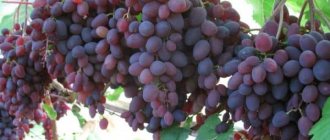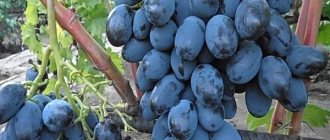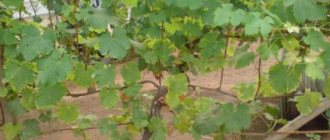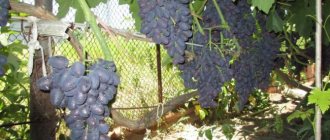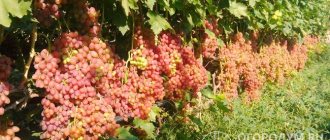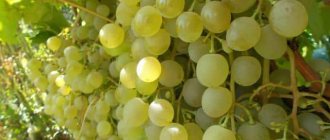The very fact that in the Urals, in a place where many plants feel quite uncomfortable, grapes can take root is quite surprising. Because this type of shrub loves sun and warmth, and the ripening period is rather long. But the fact remains a fact and there is no escaping it. Now we need to figure out which types of grapes can live in the Urals and delight with their berries.
Surprisingly, grapes can take root in the harsh Urals
Preparation
The main thing is to choose a variety that can easily withstand frost.
What needs to be done first so that the “fruit of happiness” appears on the site? This means making the right choice - choosing a variety that can easily withstand frost, so that its ripening period is fast and, of course, suitable in taste. To purchase, you must contact either breeders who have been verified by more than one gardener, or an agricultural plant nursery. In such places, they will not only recommend a more successful variety, but will also help you make a choice. For example, the city of Uralsk is famous for its Peasant Farm (plant nursery). Thanks to selection, a large number of new species of grape bushes appear every year. They are not only adapted to withstand frost, but also produce a good harvest. These varieties include: Crystal, Antario, Cardinal, Triumph and many others. All of them are different in their taste, but have proven themselves remarkably well in the markets of the world. For many years now, these species have delighted the eyes of residents of the northern part of Russia.
How to choose an uncovered grape variety
When choosing a variety, pay attention to the ripening period, care requirements, appearance of the fruit, and their taste. For regions with cool and short summers, early-ripening frost-resistant varieties are chosen, for the south - late, for central Russia - mid-ripening. For fresh consumption, seedless table grapes or grapes with small seeds are planted; any berries are suitable for processing. For the production of wine and juice - technical (wine) varieties.
If grapes are grown for sale, pay attention to their appearance. The berries should have a dense peel, elastic pulp, and a waxy coating. Fruits with thin skin are better suited for processing.
How to plant
In order to better engage in agricultural work in the northern regions, as well as preserve the crops being grown, a group of scientists made a breakthrough in this area - a special film. Any grape variety wrapped in it will be protected from winter cold. It is possible to use glass bottles as stoves. To do this, they can be lowered into the ground half their length with their neck down. The sun's rays heat the glass, which in turn transfers it to the roots. The choice of soil and planting location is the same as for standard grapes. There are no special features in this regard. Just make sure to keep the bush warm during the winter. You can follow the step by step instructions below:
- We determine the place where our grapes will show off. We strongly ask you to choose southern locations on your site.
- The hole for planting should not be deeper than 45-60 cm, and at least 45 cm wide. If you decide to plant a ridge of grapevines, you can make a trench and plant the seedlings no closer to each other than a meter.
- To improve the soil of our shrubs, you can pour fragments of brick and gravel into the bottom of the trench; all this must be covered with nutritious soil on top.
- The seedling must be planted in the hole at an angle. Make sure it is not lower than 45 degrees.
- We fill and strengthen our bush, arrange flat stones and black polyethylene on top. This will help keep the young roots warm until the fall.
- Don't forget to water thoroughly.
Planting and growing
It is best to plant seedlings in the second half of June–July, when the threat of frost has passed and the soil has warmed up to +15 ˚С. For planting, you need to choose the sunniest place on the site, where the sun does not go away all day. At the site where the grapes are planted, the soil should be loose, nutritious, moisture- and breathable.
For each bush, a feeding area of at least 1 m2 is provided. Single bushes can be planted in holes measuring 1 x 1 x 1 m. If you plan to plant bushes in a row, you need to prepare a trench 1 m wide and deep. Its length is calculated by the number of bushes: at least 1 m for each plant. The best location for the trench is from north to south. At the bottom of the hole or trench it is necessary to arrange drainage: lay 20-30 cm of large stones and cobblestones. Sprinkle a layer of 10-15 cm of expanded clay or small crushed stone on them. Fill the remaining part of the hole with a mixture of sand (or vermiculite), mature humus and garden soil. Phosphorus and potassium fertilizers and wood ash can be added to this mixture.
The planting pit is prepared 2 months before planting the seedlings, approximately in March-April. The hole needs to be watered several times so that the soil in it settles and becomes compacted. The soil should not reach the edges by 20 cm. Next year, the hole will need to be filled to the top with soil and at the same time hill up the grapes to a height of 30 cm. Bushes growing in the trench should be hilled up in the manner of potatoes - with a comb. This technique will allow you to accumulate heat in the soil around the bushes.
For a seedling, dig a small hole in the middle of the prepared hole, water it with water and plant the grapes. The soil around the seedling is compacted. Water as the soil dries, but not very much. When the seedling begins to grow, stop watering - the grapes will have enough water that is in the soil. In total, 2-3 abundant waterings are needed during the summer.
Stationary greenhouses should not be used for planting grapes, since the plant requires snow cover for successful wintering.
In the first, and sometimes in the second, year, grape seedlings are not pruned. They must gain root mass and grow 1-2 vines at least a meter long. To do this, the strongest shoots are selected from the seedling, and the rest are broken off as they appear. You can leave one additional shoot until autumn - a reserve one. In autumn, the weakest vines are removed.
If only one shoot was left on the cutting, then a strong stepson should be left on it closer to the base and pinched together with the main vine. Next year this stepson will catch up with the vine in growth. One male shoot should always be left on the plant for pollination.
Processing grapes in the summer includes watering, pinching, pinching (pinching the tops of the vines), and mulching the soil. Watering should be done at the root with a large amount of water so that the soil is well saturated. Do not water grapes on top of the foliage, especially in hot weather. It’s very good to sow green manure near the bushes; the regrown, mown grass can be left right there to mulch the soil - grapes really like it. In July, work in the vineyard should be aimed at protecting plants from fungal diseases. At the beginning of the month, you should fertilize with complex fertilizer.
Grapes always form much more buds and fruit clusters than they can “feed”. If they are all allowed to ripen, the bush will quickly weaken and the berries on it will become small. And during the short Ural summer, they simply will not ripen on time. Therefore, some of the grape clusters must be removed. Usually 3-4 ovaries are left per vine. If two brushes grow side by side, remove the smaller and weaker one. Or you can allow all the clusters to pollinate and set, and only then remove weak and sparse clusters.
As the berries ripen, they need to be carefully inspected and damaged and diseased ones removed. In September, the leaves of the fruit vine must be gradually removed to expose the berries to the sun. Do not pick off all the leaves at once - this can lead to sunburn of the bunch and vine.
As the vines grow and the berries ripen, the grapes are strengthened on a support. This could be a pole with crossbars, a trellis, or a gazebo.
Top best varieties
There are a number of varieties that thrive not only in warm climates, but also in areas where it is cold most of the year. They are also divided into covering and non-covering. Let's start our acquaintance with those who need special care. So, the best grape varieties for the Urals with mandatory covering.
There are a number of varieties that do well where it is cold most of the year.
- First on our list is Crystal. Its resistance to pathogenic fungi and various diseases is more than amazing. It is also resistant to frost, but there is a need to insulate it. As for the yield, everything is stable here; up to 10 kg of berries can be harvested from one bush annually with proper care. The ripening period is approximately 110 days. Therefore, it is considered an early type of grape.
- A hybrid of Russian breeders - Aleshkin variety. Dessert, which is capable of producing from 8 kg of grapes during the ripening period. It withstands diseases that affect most shrubs. Suitable for planting in soil in the central and southern regions of the Urals.
To be more precise, the clusters are quite powerful and branched. One bunch can hold more than 1 kg. This is what most often happens during harvest. The taste of the variety is neutral, but this type is more recommended for the production of wine products, although in fresh form it is not inferior to other varieties.
- As for Cardinal, the berries are especially tasty. It does not favor frost very much, so it is better to grow it in greenhouses and cover it better than others. At the same time, the variety has established itself as a variety that is able to live and bear fruit in such conditions.
- Pink Muscat and Antario are two varieties that were bred specifically for regions where it is quite cool in summer and very cold in winter. The varieties are early, so the harvest can be harvested in 100–110 days. The fruits are usually small in size, but have excellent taste. Hybrids amaze all breeders with their ability to develop in temperature conditions (up to -30 degrees).
There are other types of grapes that are no worse than those indicated in the top, but have excellent taste and the necessary qualities for fruiting in the conditions of the northern and northeastern regions.
Growing grapes in a greenhouse
The temperature in the greenhouse is on average 2°C...5°C higher than outside, this shortens the ripening period by two weeks, which is important for grapes. In addition, there the vine is protected from wind and frost.
When arranging a greenhouse for grapes, you need to take into account the following aspects:
- the height of the structure must be at least 2.5-3 m;
- area approximately 30 m2;
- in the conditions of the Urals and Trans-Urals, the greenhouse must have a foundation in order to avoid soil freezing;
- It is advisable to use polycarbonate instead of film;
- a strong frame is required, for example made of steel pipes;
- you also need to take care of ventilation;
- a distance of at least 40 cm is left from the top tier of the trellis to the ceiling of the greenhouse.
In a greenhouse, grapes are planted at a distance of about 0.5 m from its wall. The bushes are placed a meter from one another. The planting hole is dug approximately 70 cm deep. Drainage, as when planting grapes in open ground, is required. A prepared mixture of garden soil, river sand and humus is poured onto it in a ratio of 5:1:2, plus 100 g of superphosphate.
It is better to start growing grapes in a greenhouse with varieties such as:
- Delight;
- Korinka Russian;
- In memory of Shatilov;
- Kishmish Potapenko;
- Beauty of the North.
If the vine takes root, grows well, blooms and bears fruit, then you can move on to more heat-loving and demanding varieties.
Important! When growing grapes in a greenhouse, due to the absence of bees, you need to take care of manual pollination.
In winter, the perimeter of the greenhouse is covered with snow to prevent the soil from freezing.
A greenhouse for grapes looks like this:
Special varieties for the Urals
Few gardeners in the northern regions are willing to take the risk of growing grapevines. After all, it is quite difficult to comprehend the methods and methods of concealment. Therefore, in most cases, the idea of becoming a winegrower remains only in dreams.
Amur grapes do not require additional equipment for winter storage
Considering the fact that the cost of grape berries is very high and transportation is a rather complicated process, many breeders began to actively look for a way out of this situation. For about ten years now, varieties of uncovered grapes have appeared on the markets. It is clear that the varieties are not very popular yet due to their young age. But there is already a list showing the best non-covering grape varieties.
- The first is Amur grapes, which do not require additional equipment for winter storage of shrubs. It is able to live calmly and not react sharply to 40-degree frosts, which is a huge advantage of the variety. The only thing that is necessary is to withstand the growing season - from 125 to 140 days. This variety is considered the progenitor of many frost-resistant varieties.
It was bred from wild grapes in the mid-19th century, growing in the forests of the Primorsky and Khabarovsk Territories. Its vine can reach 30 meters. The peculiarity of the variety is that during flowering you can see two types of flowers. You can also grow a unisexual shrub. True, if we take only female inflorescences as a basis, then the grapes will be small and seedless. Many winegrowers compare them with Kishmish. They taste the same. The only thing that will upset you is the yield, which is much lower than if the plant were bisexual. It is impossible, of course, to compare the Amur variety with cultivated breeding shrubs. The berries are smaller, weighing a maximum of 250 grams. The variety grows and develops faster than conventional varieties and does not require special care. Sometimes it is used for landscaping fences, gazebos and other buildings. The shrub is able to prepare for wintering on its own. The first harvest occurs in September, since flowering usually occurs in June. As soon as you see that the fruits are ripe, you must immediately remove them. Since the grapes burst and fall off quite quickly. Wine is produced from the fruits of Amur uncovered grapes. But lovers of sweet and sour berries will also be pleased with this variety in its fresh form. A good ingredient for jelly, jam and marmalade. Most often, this grape can be found in the Southern Urals. Loves moisture and acidic soil. Therefore, it is advisable to fertilize the soil with peat. For propagation, it is better to use green cuttings, which means that planting must be done in the spring.
The seedless hybrid Venus bears fruit early
- The second group of grapes are hybrids of American varieties. There are a large number of them. Therefore, we will consider only a few of them.
- Seneca and Valiant. Two hybrids that are frost-resistant (can withstand winter temperatures down to -47). Unfortunately, their peculiarity is that in the first years they develop poorly. The taste of the berries is strawberry, which gives a special and unique aroma when preparing jam or compotes. They are also pleasant to eat raw. The harvest can be harvested by September.
- The seedless hybrid Venus bears fruit early, although they are small. But the shrub is highly developed and can withstand severe frosts. Suitable for making wine with strawberry flavor, eaten dried and raw. Sometimes used as a hedge.
- A variety such as Lucille differs from its counterparts in taste (muscat taste) and can withstand frost down to -30 degrees.
If you want to start growing grapes, then you can’t think of better shrubs than the indicated hybrids. There are other types, but they have a more sour taste and are mostly used only for landscaping or making wine drinks.
- The third group is European-American. There are more than 20 thousand species of hybrids. These varieties were developed by specialists from both continents. When creating masterpieces of grape bushes, the creators set themselves the following goals:
- varieties must be resistant to many types of fungus and other diseases;
- under no circumstances should they be afraid of frost and winds;
- cuttings should be taken quickly;
- ripening should occur earlier than conventional varieties, and vines should ripen quickly and well;
- the fruits must be large and juicy;
- high yield.
Scientists managed to achieve only half of their goals, maybe 2/3. All hybrids have really fast establishment, maturation, and increased resistance to frost. But the quality of the berries is below average.
- Amur hybrids are very popular. From a small progenitor, Russian breeders were able to make really large varieties. Every year, with the help of grafting, one of the winegrowers Chuguev (a famous breeder of grape varieties) tries to obtain new Amur varieties. Thus, the grape variety “Golden Potapenko” is white, sweet, and has interesting shapes. It is also interesting that this variety is in dire need of a northern climate and in a warm winter it not only develops poorly, but can also die. Because of this quality, the variety is named as the best uncovered grape of the Urals and the North.
- For Altai, and other northern regions where it is especially windy, you can use the R.F. variety. Sharova. The breeder did a job that many grape specialists had not achieved before. He studied all the scientific works of Michurin and other famous scientists. His process of grafting Amur with other table varieties yielded results. Now, after 40 years of hard work, there are about two dozen varieties available that can withstand severe frosts without additional shelter, excellent taste, rapid establishment and development in harsh climates.
Late varieties: exotic Siberia
A growing season of 140-150 days is rare for Siberia; almost throughout the entire territory, the warm and sunny period lasts much less. Despite this, late grape varieties are still successfully grown here, although this is rather rare.
Dubinushka
This variety is often classified as a mid-late, or less often as a late, grape variety. Created specifically for the conditions of Southern Siberia, it takes root in more severe climatic conditions, however, it requires careful covering for the winter, proper awakening and rather complex care. Its advantages include:
- excellent taste properties;
- rich color and tart aroma;
- large berries;
- high productivity.
Grapes of this variety can be improved by grafting to a species with higher frost resistance.
On a note!
Late varieties are best planted in shelters and greenhouses; low-growing, weakly bushy species are suitable for such conditions.
Katyr
The most common variety is Katyr-2, obtained from grafting and crossing frost-resistant and more whimsical dessert varieties. This late variety does not need earthen shelter; under favorable conditions, the berries can remain on the vine until mid-October, and they fully ripen only by the end of September. The main difference from similar varieties is the complex, sweet and sour rich taste, which receives high tasting marks. Both the first and second generation varieties are low-yielding. Large berries are convenient to pick, however, the vines themselves are quite thin, massive clusters are formed very rarely.
Is it possible to become a breeder?
There is nothing easier than trying not only to grow grapes, but also to become a tester of new varieties that can develop and produce crops in cold climates. You may not become a famous winegrower, but it is quite possible to develop a new variety for yourself. To do this, you need to understand the technology of grafting. This will require several types of vines. You can prepare them yourself in the fall or purchase them ready-made. Soak in water for several days, preferably 48 hours. Next, you need to choose a grafting method. You can use the root for this, or you can also use the lower shoot, which is closer to the ground. The main thing is that the weather is suitable during grafting, that everything is done correctly, that our cuttings are secured and insulated at the correct angle. Well, northern viticulture is gradually and confidently increasing the number of admirers and those willing to take up such a difficult task. We can only wish good luck to everyone who wants to have tasty and juicy fruits.
What are uncovered grape varieties?
Frost resistance of most grape varieties does not exceed -24°C, but some can withstand temperatures as low as -28°C. The vines do not freeze in winter, so there is no need to cover them for the winter. That is why such grapes are called uncovered. It is distributed in all regions - from the south to central Russia, the Urals and Siberia. Gardeners do not need to waste time preparing covering material and carrying out the procedure itself.
Grapes in the Southern Urals video
The climate of this region is harsh:
- winters are snowy, with frosts down to -40°C;
- Summer is short, it can be rainy and cold, there are frosts already in August, and there is a sharp temperature difference between day and night.
Therefore, in order to grow this crop in the Urals, you need to take into account all weather conditions and adhere to special agricultural techniques, since traditional care will lead to the death of the plant.
The main thing is to choose winter-hardy and early-ripening varieties. Their list is quite wide, since scientists have put a lot of effort into creating varieties adapted to unfavorable climatic conditions.
